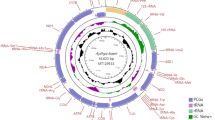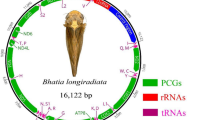Abstract
In the present study, the complete mitochondrial genomes of three Night Herons from the genus Gorsachius were sequenced. All the complete mitochondrial genomes in this genus exhibit duplications in the region between cytochrome b and 12S ribosomal RNA. In Gorsachius magnificus, the duplicated regions span from the last 108 base pairs of cytochrome b to the control region, which are nearly identical to each other in nucleotide sequences, suggesting they are evolving in concert. In G. goisagi and G. melanolophus, the duplicated control regions were nearly identical in majority portions within each individual, while the first tRNA Pro-ND6-tRNA Glu and the second Cytb-tRNA Thr regions have degenerated into non-coding regions. Phylogenetic analyses with Bayesian inference and maximum likelihood based on the nucleotide sequences of two ribosomal RNA genes and 12 protein coding genes indicate that G. magnificus is not monophyletic with the other two Gorsachius species. These new results provide the fundamental basis for further studies to elucidate their phylogenetic positions and relationships with other genera within the subfamily Ardeinae.
Zusammenfassung
Vollständiges mitochondriales Genom ergibt Nicht-Monophylie der Nachtreiher-Gattung Gorsachius In der vorliegenden Studie wurde das vollständige mitochondriale Genom von drei Nachtreiherarten der Gattung Gorsachius sequenziert. Alle mitochondrialen Genome dieser Gattung wiesen Duplikationen in der Region zwischen Cytochrome b und 12S der ribosomalen RNA auf. Bei G. magnificus umfassten die duplizierten Regionen die letzten 108 Basenpaare von Cytochrome b bis zur Kontrollregion, die nahezu identisch sind in ihren Nukleotidsequenzen. Dies deutet auf eine gemeinsame Entwicklung hin. Bei G. goisagi und G. melanolophus waren die mehrheitlichen Anteile der duplizierten Kontrollregionen nahezu bei jedem Individuum identisch, während die ersten tRNAPro-ND6-tRNAGlu und die zweiten CytbtRNAThr Regionen zu nicht-kodierenden Regionen degeneriert waren. Phylogenetische Analysen mittels Bayes-Inferenz und Maximum Likelihood Schätzung, die auf den Nukleotidsequenzen zweier ribosomaler RNA Gene und 12 Protein kodierender Gene basierten, zeigten, dass G. magnificus nicht der gleichen Stammform entstammt wie die beiden anderen Gorsachius-Arten. Diese neuen Erkenntnisse liefern die fundamentale Basis für weitere Studien zur Aufklärung phylogenetischer Positionen und Verwandtschaftsverhältnisse mit anderen Gattungen innerhalb der Unterfamilie der Ardeinae.



Similar content being viewed by others
References
Abbott CL, Double MC, Trueman JW, Robinson A, Cockburn A (2005) An unusual source of apparent mitochondrial heteroplasmy: duplicate mitochondrial control regions in Thalassarche albatrosses. Mol Ecol 14:3605–3613. doi:10.1111/j.1365-294X.2005.02672.x
Avise JC (1994) Molecular markers: natural history and evolution. Chapman & Hall, New York
Bensch S, Harlid A (2000) Mitochondrial genomic rearrangements in songbirds. Mol Biol Evol 17:107–113. doi:10.1093/oxfordjournals.molbev.a026223
Bock WJ (1956) A generic review of the family Ardeidae (Aves). Am Mus Novit 1779:1–49
Boore JL (1999) Animal mitochondrial genomes. Nucleic Acids Res 27:1767–1780. doi:10.1093/nar/27.8.1767
Castresana J (2000) Selection of conserved blocks from multiple alignments for their use in phylogenetic analysis. Mol Biol Evol 17:540–552. doi:10.1093/oxfordjournals.molbev.a026334
Clayton DA (1992) Transcription and replication of animal mitochondrial DNAs. Int Rev Cytol 141:217–232. doi:10.1016/S0074-7696(08)62067-7
Desjardins P, Morais R (1990) Sequence and gene organization of the chicken mitochondrial genome. A novel gene order in higher vertebrates. J Mol Biol 212:599–634. doi:10.1016/0022-2836(90)90225-B
Eberhard JR, Wright TF, Bermingham E (2001) Duplication and concerted evolution of the mitochondrial control region in the parrot genus Amazona. Mol Biol Evol 18:1330–1342
Edgar RC (2004) MUSCLE: multiple sequence alignment with high accuracy and high throughput. Nucleic Acids Res 32:1792–1797. doi:10.1093/nar/gkh340
Fellowes JR, Fang Z, Shing LK, Hau BCH, Lau MWN, Lam VWY, Young L, Hafner H (2001) Status update on white-eared night heron Gorsachius magnificus in South China. Bird Conserv Int 11:101–111. doi:10.1017/S0959270901000193
Gibb GC, Kardailsky O, Kimball RT, Braun EL, Penny D (2007) Mitochondrial genomes and avian phylogeny: complex characters and resolvability without explosive radiations. Mol Biol Evol 24:269–280. doi:10.1093/molbev/msl158
Gibb GC, Kennedy M, Penny D (2013) Beyond phylogeny: pelecaniform and ciconiiform birds, and long-term niche stability. Mol Phylogenet Evol 68:229–238. doi:10.1016/j.ympev.2013.03.021
Gill F, Donsker D (2015) IOC world bird list (v 5.2). Available at: http://www.worldbirdnames.org. Accessed 1 Feb 2015
Haddrath O, Baker AJ (2001) Complete mitochondrial DNA genome sequences of extinct birds: ratite phylogenetics and the vicariance biogeography hypothesis. Proc R Soc Lond B 268:939–945. doi:10.1098/rspb.2001.1587
Haring E, Kruckenhauser L, Gamauf A, Riesing MJ, Pinsker W (2001) The complete sequence of the mitochondrial genome of Buteo buteo (Aves, Accipitridae) indicates an early split in the phylogeny of raptors. Mol Biol Evol 18:1892–1904. doi:10.1093/oxfordjournals.molbev.a003730
Hu JH, Liu Y (2014) Unveiling the conservation biogeography of a data-deficient endangered bird species under climate change. PLoS ONE 9(1):e84529. doi:10.1371/journal.pone.0084529
IUCN (2014) The IUCN red list of threatened species. Version 2014.3. Available at http://www.iucnredlist.org. Accessed 1 Feb 2015
Kawakami K, Fujita M, Hasegawa M, Makihara H (2011) Dietary characteristics of the Malayan night heron (Gorsachius melanolophus) in the Yaeyama Islands, southern Japan. Chin Birds 2:87–93. doi:10.5122/cbirds.2011.0015
King B (2005) Vocalisation of the white-eared night heron Gorsachius magnificus. Forktail 21:177
Kurabayashi A, Sumida M, Yonekawa H, Glaw F, Vences M, Hasegawa M (2008) Phylogeny, recombination, and mechanisms of stepwise mitochondrial genome reorganization in mantellid frogs from Madagascar. Mol Biol Evol 25:874–891. doi:10.1093/molbev/msn031
Kushlan JA, Hancock JA (2005) Herons (Ardeidae) (Bird Families of the World). Oxford University Press, Oxford
Lanfear R, Calcott B, Ho SY, Guindon S (2012) Partitionfinder: combined selection of partitioning schemes and substitution models for phylogenetic analyses. Mol Biol Evol 29:1695–1701. doi:10.1093/molbev/mss020
Li BC, Jing PP, Ding P (2007) First breeding observations and a new locality record of white-eared night-heron Gorsachius magnificus in southeast China. Waterbirds 30:301–304. doi:10.1675/1524-4695(2007)30[301:fboaan]2.0.co;2
Lowe TM, Eddy SR (1997) tRNAscan-SE: a program for improved detection of transfer RNA genes in genomic sequence. Nucleic Acids Res 25:0955–0964. doi:10.1093/nar/25.5.0955
McCracken KG, Sheldon FH (1997) Avian vocalizations and phylogenetic signal. Proc Natl Acad Sci USA 94:3833–3836
McCracken KG, Sheldon FH (1998) Molecular and osteological heron phylogenies: sources of incongruence. Auk 115:127–141. doi:10.2307/4089118
Miller MA, Pfeiffer W, Schwartz T (2010) Creating the CIPRES Science Gateway for inference of large phylogenetic trees. Proc Gatew Comput Environ Work. doi:10.1109/GCE.2010.5676129
Mindell DP, Sorenson MD, Dimcheff DE (1998a) An extra nucleotide is not translated in mitochondrial ND3 of some birds and turtles. Mol Biol Evol 15:1568–1571. doi:10.1093/oxfordjournals.molbev.a025884
Mindell DP, Sorenson MD, Dimcheff DE (1998b) Multiple independent origins of mitochondrial gene order in birds. Proc Natl Acad Sci USA 95:10693–10697
Oh H, Kim Y, Kim N (2010) First breeding record of Japanese night heron Gorsachius goisagi in Korea. Ornithol Sci 9:131–134
Ojala D, Montoya J, Attardi G (1981) tRNA punctuation model of RNA processing in human mitochondria. Nature 290:470–474. doi:10.1038/290470a0
Payne RB, Risley CJ (1976) Systematics and evolutionary relationships among the herons (Ardeidae). Mus Zool Univ Michigan Misc Publ 150:1–115
Peters JL (1931) Check-list of birds of the world. Harvard University Press, Cambridge
Pilgrim JD, Walsh DF, Tran TT, Nguyen DT, Eames JC, Le MH (2009) The endangered white-eared night heron Gorsachius magnificus in Vietnam: status, distribution, ecology and threats. Forktail 25:142–146
Quinn TW, Wilson AC (1993) Sequence evolution in and around the mitochondrial control region in birds. J Mol Evol 37:417–425. doi:10.1007/BF00178871
Rambaut A, Suchard M, Xie D, Drummond A (2014) Tracer v1. 6. Available at http://beast.bio.ed.ac.uk/Tracer
Ramirez V, Savoie P, Morais R (1993) Molecular characterization and evolution of a duck mitochondrial genome. J Mol Evol 37:296–310. doi:10.1007/BF00175506
Ronquist F, Teslenko M, van der Mark P, Ayres DL, Darling A, Höhna S, Larget B, Liu L, Suchard MA, Huelsenbeck JP (2012) MrBayes 3.2: efficient Bayesian phylogenetic inference and model choice across a large model space. Syst Biol 61:539–542. doi:10.1093/sysbio/sys029
Ruokonen M, Kvist L (2002) Structure and evolution of the avian mitochondrial control region. Mol Phylogenet Evol 23:422–432. doi:10.1016/S1055-7903(02)00021-0
Sammler S, Bleidorn C, Tiedemann R (2011) Full mitochondrial genome sequences of two endemic Philippine hornbill species (Aves: Bucerotidae) provide evidence for pervasive mitochondrial DNA recombination. BMC Genom 12:35. doi:10.1186/1471-2164-12-35
Sammler S, Ketmaier V, Havenstein K, Tiedemann R (2013) Intraspecific rearrangement of duplicated mitochondrial control regions in the Luzon Tarictic Hornbill Penelopides manillae (Aves: Bucerotidae). J Mol Evol 77:199–205. doi:10.1007/s00239-013-9591-y
Schirtzinger EE, Tavares ES, Gonzales LA, Eberhard JR, Miyaki CY, Sanchez JJ, Hernandez A, Mueller H, Graves GR, Fleischer RC, Wright TF (2012) Multiple independent origins of mitochondrial control region duplications in the order Psittaciformes. Mol Phylogenet Evol 64:342–356. doi:10.1016/j.ympev.2012.04.009
Sheldon FH (1987) Phylogeny of herons estimated from DNA–DNA hybridization data. Auk 104:97–108. doi:10.2307/4087238
Sheldon FH, Jones CE, McCracken KG (2000) Relative patterns and rates of evolution in heron nuclear and mitochondrial DNA. Mol Biol Evol 17:437–450
Singh TR, Shneor O, Huchon D (2008) Bird mitochondrial gene order: insight from 3 warbler mitochondrial genomes. Mol Biol Evol 25:475–477. doi:10.1093/molbev/msn003
Stamatakis A (2014) RAxML version 8: a tool for phylogenetic analysis and post-analysis of large phylogenies. Bioinformatics 30:1312–1313. doi:10.1093/bioinformatics/btu033
Tamura K, Stecher G, Peterson D, Filipski A, Kumar S (2013) MEGA6: molecular evolutionary genetics analysis version 6.0. Mol Biol Evol 30:2725–2729. doi:10.1093/molbev/mst197
Treutlein TL, Gonzalez J, Wink M (2015) Phylogeny of water birds inferred from mitochondrial DNA sequences of nine protein coding genes. PeerJ. doi:10.7287/peerj.preprints.272v1
Verkuil YI, Piersma T, Baker AJ (2010) A novel mitochondrial gene order in shorebirds (Scolopacidae, Charadriiformes). Mol Phylogenet Evol 57:411–416. doi:10.1016/j.ympev.2010.06.010
Wolstenholme DR (1992) Animal mitochondrial DNA: structure and evolution. Int Rev Cytol 141:173–216. doi:10.1016/S0074-7696(08)62066-5
Zhou X, Lin Q, Fang W, Chen X (2014) The complete mitochondrial genomes of sixteen ardeid birds revealing the evolutionary process of the gene rearrangements. BMC Genom 15:573. doi:10.1186/1471-2164-15-573
Acknowledgments
We thank the Jiulingshan National Reserve in Jiangxi and the Endemic Species Research Institute in Taiwan, for help in providing the tissue samples for this study. This research was supported by the National Natural Science Foundation of China (Grant Nos. 31000963, 41476113 and 31272333) and by the Fujian Natural Science Foundation of China (2010Y2007).
Author information
Authors and Affiliations
Corresponding authors
Additional information
Communicated by M. Wink.
Electronic supplementary material
Below is the link to the electronic supplementary material.
10336_2015_1297_MOESM1_ESM.pdf
Supplementary material 1 (PDF 164 kb) Alignments of the duplicated CRs in Gorsachius. Dots indicate identity of nucleotides to the reference sequence, and dashes indicate gaps. Underlined nucleotides indicate the conserved motifs characteristic for the avian CR. The red and blue nucleotides indicate the sequences are more similar between G. goisagi and G. melanolophus orthologs than between paralogs within species. The gray-shaded nucleotides indicate the repeats.
Rights and permissions
About this article
Cite this article
Zhou, X., Yao, C., Lin, Q. et al. Complete mitochondrial genomes render the Night Heron genus Gorsachius non-monophyletic. J Ornithol 157, 505–513 (2016). https://doi.org/10.1007/s10336-015-1297-z
Received:
Revised:
Accepted:
Published:
Issue Date:
DOI: https://doi.org/10.1007/s10336-015-1297-z




